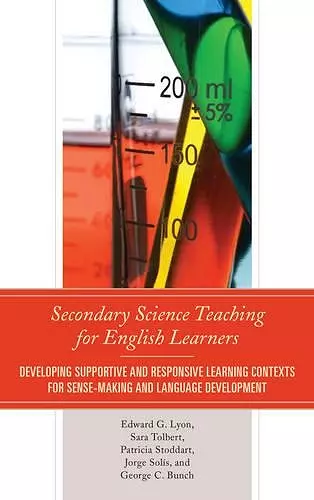Secondary Science Teaching for English Learners
Developing Supportive and Responsive Learning Contexts for Sense-Making and Language Development
Sara Tolbert author George C Bunch author Edward G Lyon author Jorge Solís author Patricia Stoddart author
Format:Paperback
Publisher:Rowman & Littlefield
Published:13th Jun '16
Currently unavailable, and unfortunately no date known when it will be back
This paperback is available in another edition too:
- Hardback£89.00(9781442231252)

This book presents a framework that connects science teaching with students’ experiences and communities, offering strategies for educators to effectively support English learners in linguistically diverse classrooms.
Secondary Science Teaching for English Learners: Developing Supportive and Responsive Learning Contexts for Sense-Making and Language Development presents a comprehensive framework that highlights the interconnectedness of scientific sense-making and the use of disciplinary language and literacy practices. The authors advocate for contextualized teaching, which links science education to students' lived experiences, sociocultural backgrounds, and both local and global communities. This resource is designed for a diverse audience, including pre-service and in-service secondary science teachers, educators, instructional coaches, curriculum specialists, and administrators, all of whom can benefit from a research-based approach tailored to the increasing number of English learners in the United States.
The book introduces the Secondary Science Teaching with English Language and Literacy Acquisition (SSTELLA) Framework, which emphasizes the importance of meaningful and relevant learning experiences that incorporate discipline-specific literacy. It outlines four core teaching practices essential for effective science instruction: contextualized science activities, scientific sense-making through engineering practices, scientific discourse, and the development of English language and disciplinary literacy. These practices are grounded in robust theoretical and research foundations, allowing for adaptable and unscripted lesson modifications that cater to the needs of linguistically diverse classrooms.
Furthermore, Secondary Science Teaching for English Learners provides historical and theoretical insights into the integration of language, literacy, and science instruction in multilingual settings. It offers explicit models and guided support to help educators implement effective teaching strategies, including comparative vignettes that illustrate different classroom practices. This resource ultimately aims to enhance students' engagement with core scientific concepts while fostering their reading, writing, and communication skills in a supportive learning environment.
Teachers who work with English Language Learning (ELL) students have an excellent resource in the book Secondary Science Teaching for English Learners. This book provides strategies for helping their students make sense of science. One of the major challenges of teaching science to ELL students is helping them to understand science concepts while they are still developing their mastery of a new language. This book provides several examples of effective teaching strategies along with the research that validates each approach.... Secondary Science Teaching for English Learners is written for secondary science teachers and the ELL teachers who work collaboratively with them. The SSTELLA framework and the four practices that are highlighted provide a solid framework for teachers to create lessons that will help their students better understand challenging science concepts and thus prepare them for the future. * NSTA Recommends *
This book is a unique resource for science teachers who work wth English Language Learners. Every chapter is filled with examples of effective classroom strategies for instruction and describes the supporting research in accessible ways. All of us who teach science in schools can learn from this text how to design units, scaffold instruction, and set up rich discourse environments that work for all students. -- Mark Windschitl, professor of Science Education, University of Washington
Those of us who work to provide content area support for secondary school English learners and their teachers have grown accustomed to the fact that there are few high quality, research-based resources available to aid us in meeting this challenge. Secondary Science Teaching for English Learners fills this need admirably, providing concrete strategies that are both theoretically grounded and practically tested in a range of secondary school classrooms. The SSTELLA Framework provides a clear blueprint for how language development and science learning can and must play synergistic roles in the secondary science classroom. -- Cory Buxton, Athletic Association Professor of Education, University of Georgia
Secondary Science Teaching for English Learners bridges the elusive gap between content and language instruction for English Learners in the critical content domain of science, addressing the intersections of curriculum, instruction and assessment. This is an important contribution for researchers, teacher educators, teachers, and policy makers. -- Eugene E. Garcia, professor emeritus, Arizona State University
A marvelous book providing real classroom examples of science, literacy and language instruction in action. The authors carefully construct theoretically sound and research based practices to help educators understand and deliver curriculum and instruction to teach and support all students’ engagement with scientific concepts and practices. Having read this book, I will immediately adopt it for my content area/disciplinary literacy classes and will encourage my science methods colleagues to do the same. This ground breaking work is a model for future projects that are desperately needed to make critical linkages between language, literacy and the disciplines. -- Patricia L. Anders, Jewell M. Lewis Distinguished Professor of Reading, Language, Reading and Culture Program, University of Arizona
ISBN: 9781442231269
Dimensions: 229mm x 151mm x 18mm
Weight: 386g
258 pages